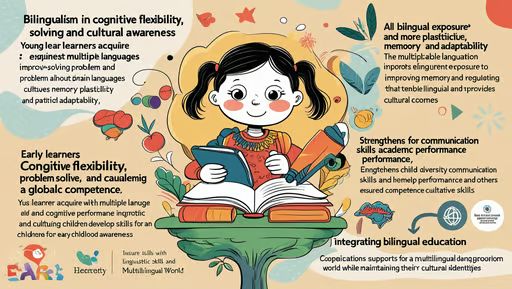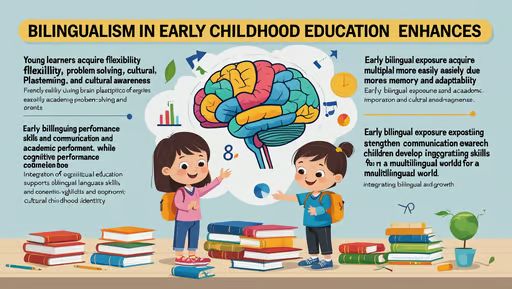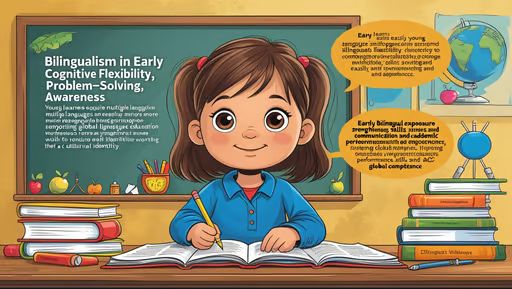Abstract
Bilingualism in Early Childhood Education, Bilingualism, the ability to speak and understand two languages fluently, has become an increasingly important topic in early childhood education. As globalization continues to shrink the world, the demand for bilingual individuals has grown, leading to a greater emphasis on bilingual education in the early years. This article explores the benefits and challenges of bilingualism in early childhood education, the cognitive and social-emotional impacts on children, and the various approaches to implementing bilingual education in preschool and primary school settings. The article also discusses the role of parents, educators, and policymakers in fostering bilingualism and concludes with recommendations for future research and practice.
Introduction
Bilingualism is a multifaceted phenomenon that has been studied extensively in the fields of linguistics, psychology, and education. In the context of early childhood education, bilingualism refers to the ability of young children to understand and use two languages proficiently. Early childhood, typically defined as the period from birth to eight years old, is a critical time for language development. During this period, children’s brains are highly plastic, making it an ideal time for language acquisition. As a result, early childhood education programs that incorporate bilingualism have the potential to significantly impact children’s cognitive, linguistic, and social-emotional development.
The importance of bilingualism in early childhood education has recognized by educators, researchers, and policymakers around the world. In many countries, bilingual education programs have been implemented to promote linguistic diversity, support minority language communities, and prepare children for a globalized world. However, the implementation of bilingual education in early childhood settings is not without challenges. This article aims to provide a comprehensive analysis of bilingualism in early childhood education, exploring its benefits, challenges, and implications for practice.
The Benefits of Bilingualism in Early Childhood Education
Cognitive Benefits
Research has consistently shown that bilingualism confers cognitive advantages, particularly in the areas of executive function, problem-solving, and metalinguistic awareness. Executive function refers to a set of cognitive processes that are responsible for goal-directed behavior, including working memory, cognitive flexibility, and inhibitory control. Bilingual children have been found to outperform monolingual children on tasks that require executive function, such as switching between tasks, inhibiting irrelevant information, and maintaining attention.
One explanation for these cognitive advantages is that bilingual children constantly managing two linguistic systems, which requires them to exercise greater cognitive control. For example, when a bilingual child is speaking one language, they must inhibit the other language to avoid interference. This constant practice in managing two languages strengthens the brain’s executive control system, leading to enhanced cognitive abilities.Metalinguistic awareness, or the ability to think about and reflect on language as an object of thought, another cognitive benefit associated with bilingualism. Bilingual children are often more aware of the structure and rules of language, as they must navigate the differences between their two languages. This heightened metalinguistic awareness can facilitate the acquisition of additional languages and improve literacy skills.
Linguistic Benefits
Bilingualism in early childhood education also offers linguistic benefits. Children who are exposed to two languages from an early age have the opportunity to develop proficiency in both languages, which can enhance their communication skills and broaden their cultural horizons. Bilingual children are often better at understanding and interpreting language in different contexts, as they accustomed to switching between languages depending on the situation. Moreover, bilingualism can provide a foundation for the acquisition of additional languages later in life. Research has shown that bilingual individuals are more adept at learning new languages, as they have already developed the cognitive and linguistic skills necessary for language learning. This can be particularly advantageous in a globalized world where multilingualism increasingly valued.
Social-Emotional Benefits
In addition to cognitive and linguistic benefits, bilingualism in early childhood education can have positive social-emotional effects. Bilingual children often have a greater appreciation for cultural diversity and are more open to different perspectives. This can lead to increased empathy, tolerance, and social competence.Bilingualism can also enhance children’s sense of identity and belonging. For children from minority language backgrounds, being able to speak their heritage language can strengthen their connection to their cultural roots and foster a positive self-concept. Additionally, bilingual children may feel a sense of pride and accomplishment in being able to communicate in two languages, which can boost their self-esteem.

Challenges of Bilingualism in Early Childhood Education
Language Dominance and Balance
One of the challenges of bilingualism in early childhood education is achieving a balance between the two languages. In many cases, one language may become dominant, while the other language is used less frequently. This can occur when one language is more prevalent in the child’s environment, such as the majority language spoken in the community or at school.Language dominance can lead to uneven development in the two languages, with one language being stronger than the other. This can create challenges for children when they are required to use the less dominant language, particularly in academic settings. Educators and parents must be mindful of this issue and strive to provide equal exposure and support for both languages.
Code-Switching and Language Mixing
Code-switching, or the practice of alternating between two languages within a conversation, is a common phenomenon among bilingual individuals. While code-switching is a natural and often unconscious process, it can sometimes be perceived as a lack of proficiency in one or both languages. In early childhood education, educators may need to address code-switching and language mixing to ensure that children develop proficiency in both languages.However, it is important to recognize that code-switching is not necessarily a sign of language confusion or deficiency. In fact, code-switching can be a sophisticated linguistic skill that reflects a deep understanding of both languages. Educators should approach code-switching with sensitivity and use it as an opportunity to reinforce language learning.
Parental and Educator Attitudes
The attitudes of parents and educators play a crucial role in the success of bilingual education programs. Some parents may be concerned that exposing their child to two languages at an early age could lead to language delay or confusion. These concerns are often based on misconceptions about bilingualism, as research has shown that bilingual children do not experience language delays and are not more likely to be confused than monolingual children.Educators may also have varying attitudes toward bilingualism, depending on their own experiences and beliefs. Some educators may view bilingualism as an asset, while others may see it as a challenge or barrier to learning. It is essential for educators to receive training and support to understand the benefits of bilingualism and to develop strategies for promoting bilingualism in the classroom.
Approaches to Bilingual Education in Early Childhood
Dual Language Programs
Dual language programs, also known as two-way immersion programs, are a popular approach to bilingual education in early childhood. These programs aim to develop bilingualism and biliteracy by providing instruction in two languages. In a dual language program, children from different language backgrounds are taught together, with the goal of promoting language development and cross-cultural understanding.Dual language programs typically follow a 50/50 model, where instruction divided equally between the two languages. For example, children may receive instruction in English for half of the day and in Spanish for the other half. This approach ensures that both languages are given equal importance and that children have ample opportunities to develop proficiency in both languages.
Transitional Bilingual Education
Transitional bilingual education programs designed to support children who are learning the majority language while maintaining their heritage language. In these programs, children initially receive instruction in their heritage language, with a gradual transition to instruction in the majority language. The goal of transitional bilingual education is to help children develop proficiency in the majority language while maintaining their heritage language skills.Transitional bilingual education programs often implemented in communities with a high concentration of minority language speakers. These programs can be particularly beneficial for children who are at risk of losing their heritage language due to the dominance of the majority language in their environment.
Language Immersion Programs
Language immersion programs are another approach to bilingual education in early childhood. In a language immersion program, children immersed in a second language, with the goal of developing proficiency in that language. Immersion programs can be either partial or full, depending on the amount of time spent in the second language.In a partial immersion program, children receive instruction in the second language for a portion of the day, while in a full immersion program, instruction conducted entirely in the second language. Language immersion programs are often used to teach a minority language or a foreign language, such as French or Mandarin, to children who native speakers of the majority language.

The Role of Parents, Educators, and Policymakers
Parents
Parents play a critical role in fostering bilingualism in early childhood. They are often the primary source of language input for young children, particularly in the early years. Parents can support bilingualism by speaking to their children in their heritage language, providing opportunities for language practice, and exposing their children to a rich linguistic environment.It is important for parents to be consistent in their use of language and to create a positive and supportive environment for language learning. Parents should also be aware of the benefits of bilingualism and prepared to advocate for their child’s language needs in educational settings.
Educators
Educators are key players in the implementation of bilingual education programs. They are responsible for creating a language-rich environment that supports the development of both languages. Educators should trained in bilingual education strategies and be knowledgeable about the cognitive and linguistic benefits of bilingualism.In the classroom, educators can promote bilingualism by using both languages in instruction, providing opportunities for language practice, and encouraging children to use both languages in their interactions. Educators should also be sensitive to the cultural backgrounds of their students and incorporate culturally relevant materials and activities into the curriculum.
Policymakers
Policymakers have the power to shape the landscape of bilingual education through legislation, funding, and support for bilingual programs. It should recognize the value of bilingualism and prioritize the development of bilingual education programs in early childhood settings.Policymakers can also play a role in addressing the challenges of bilingual education, such as language dominance and code-switching, by providing resources and support for educators and parents. Additionally, policymakers should work to ensure that bilingual education programs are accessible to all children, regardless of their socioeconomic background or language proficiency.
Conclusion
Bilingualism in early childhood education offers numerous cognitive, linguistic, and social-emotional benefits. However, the implementation of bilingual education programs is not without challenges, including language dominance, code-switching, and varying attitudes toward bilingualism. To maximize the benefits of bilingualism, it is essential for parents, educators, and policymakers to work together to create a supportive environment for language learning.
Future research should continue to explore the long-term effects of bilingualism on children’s development, as well as the most effective strategies for promoting bilingualism in early childhood education. By investing in bilingual education, we can prepare children for a globalized world and foster a greater appreciation for linguistic and cultural diversity.
References
- Bialystok, E. (2001). Bilingualism in development: Language, literacy, and cognition. Cambridge University Press.
- Cummins, J. (2000). Language, power, and pedagogy: Bilingual children in the crossfire. Multilingual Matters.
- García, O., & Wei, L. (2014). Translanguaging: Language, bilingualism, and education. Palgrave Macmillan.
- Genesee, F., & Nicoladis, E. (2006). Bilingual acquisition. In E. Hoff & M. Shatz (Eds.), Blackwell Handbook of Language Development (pp. 324-342). Blackwell Publishing.
- Hakuta, K. (1986). Mirror of language: The debate on bilingualism. Basic Books.
- Paradis, J., Genesee, F., & Crago, M. B. (2011). Dual language development and disorders: A handbook on bilingualism and second language learning. Paul H. Brookes Publishing.
- Thomas, W. P., & Collier, V. P. (2002). A national study of school effectiveness for language minority students’ long-term academic achievement. Center for Research on Education, Diversity & Excellence.

11 thoughts on “Bilingualism in Early Childhood Education”
Comments are closed.